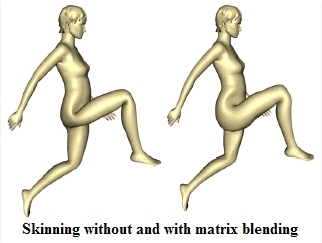Frederic Cordier |
|
|
|
|
|
Research Topics: Texture Mapping Cloth Simulation |
Real-Time Cloth Simulation (See publications) Real-time cloth simulation has
been my research topic for the last three years. During the last decade,
extensive research has been carried out in cloth simulation. Most of these
techniques aim to develop a mechanical model for realistic cloth simulation.
Only few of them were targeted for real-time application. In fact, the
constraint of real-time on cloth simulation makes it necessary to develop
different techniques. Two different approaches have
been investigated. The first one consists of developing a mechanical model
that can simulate the cloth movements. This mechanical model makes use of
simplifications wherever it is possible (collision detection, mechanical
model). See the videos (QuickTime format) of the trouser (3.5 Mb), skirt (3 Mb) and dress
(3 Mb) animated in real-time.
The second approach makes use of
a pre-computed cloth animation. Starting from a pre-computed cloth animation,
the method learns the relation between the joint motion and the cloth
movement. The learnt movement allows the real-time simulation of the cloth
movement given the joint motion. The demonstration
video (QuickTime format, 12 Mb) is available.
A detailed description
of these two approaches is available in my PhD
dissertation. Case studies for Real-Time Cloth
Simulation My work on cloth simulation has
also involved the development of tools to create and animate virtual humans
for real-time platform. ·
“BodyManager” (co-developer: Hyewon SEO), a plug-in to 3ds max,
manages everything that concerns the reuse of the 3D character and motion
data in real-time simulation platform, support of H-Anim standard, motion conversion, and
preprocessing for the real-time cloth simulation. It has become one of the
most frequently used tools in MIRALab
and VRLab. ·
"Virtual TryOn", a system developed for garment retail and preview, is
based on intensive use of real-time cloth simulation. Hyewon SEO has
developed another main component of this system - a dynamic body sizing.
Christian Luible designed the clothes as seen from snapshots below.
·
The
robustness of the method has been demonstrated at C&A booth, Hambourg
(Oct. 2002), PorteOuvert of CUI,
Skin Deformation The development of a new skeleton-driven deformation method was not the main purpose of my research. However, the way the skin deforms is important since the skin shape forms the basis in the cloth deformation method described above. The skeleton-driven deformation is based on matrix blending (more details in my PhD dissertation).
|
|
|
|





